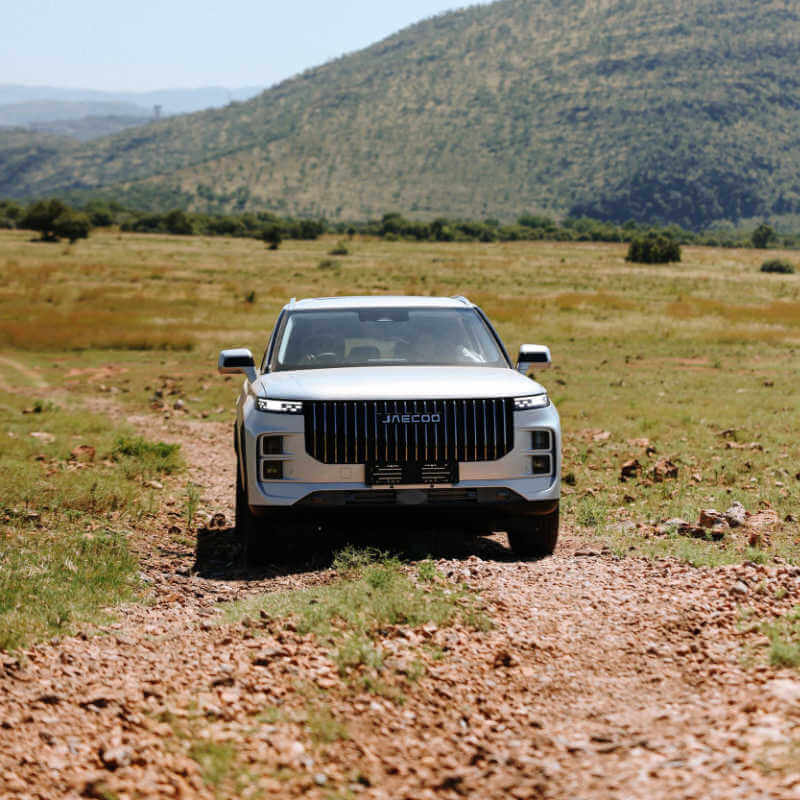The New Toyota Yaris
- Arresting, emotive design and a major advance in sensory quality
- Revised three-cylinder 1.0-litre engine and high efficiency hybrid
- Modified vehicle dynamics for enhanced driveability and ride comfort
Toyota has invested 85 million Euros, engineered 1 000 new parts and spent 576 000 man hours refining the new Yaris. The result is a thorough visual refresh, inside and out, the adoption of upmarket cabin textures and materials, as well as a host of under-the-skin modifications to make the new Yaris a whole lot more desirable.
“Assertive, contemporary styling with a distinctly European flavour and a feisty new attitude,” is how Glenn Crompton, Vice President of Marketing for Toyota SA Motors pitches the revamped hatch.
“Yaris has always been a sound rational choice. But what we wanted – and feel we have now achieved – with the latest model, is a car that not only connects with our customers’ brains, but also with their hearts.”
After exhaustive research conducted across several platforms including press analysis, customer clinics and dealer feedback, Toyota Europe identified three key areas where the current generation Yaris scored highly – outstanding roominess, powertrain efficiency and standard features, making it the smart choice. In the area of emotional appeal, however, there was room to improve. The focus was therefore placed on upgrading the aesthetics, most notably exterior styling and interior plastics, as well as honing in on driving pleasure by enhancing driveability, ride comfort and noise levels.
A fourth element has been factored in and that’s value for money. As Crompton points out, “the new Yaris petrol models are arguably the best value proposition in the highly competitive B segment. Quality finishes backed up by a comprehensive suite of standard kit ensure that it stays ahead of the pack. Not forgetting, of course, the unique proposition of its hybrid powertrain – still the only vehicle of its kind in this class.”
Styling that stands out from the crowd
Eschewing supermini stereotypes for a highly distinctive exterior, the new Yaris sees the most dramatic execution of Toyota’s contemporary frontal design language to date with sharp-edged detailing.
The narrow upper and large trapezoidal grilles, a hallmark of Toyota’s current design, are present but the design twist is that they now merge at the point of the Toyota emblem to form a powerful cross shape.
Another recurring design trait is the chrome trim bar which runs through the length of the upper grille into new headlamp clusters, tying the frontal elements together in a powerful, horizontal emphasis of the car’s width.
The headlamps themselves use projector technology (Hybrid) for high and low beams and the clusters incorporate standard daytime running lights (LED for the hybrid).
In profile, Yaris displays a new door belt moulding and door mirrors – the look is rounded off by standard 15-inch alloys across the range.
At the rear, a new bumper design gives the appearance of a broad, lower stance, with an integral faux diffuser adding to the car’s more athletic road presence.
The introduction of the new 2014 Yaris sees both versions – petrol and hybrid – sharing the same overall styling, with just a few subtle cues differentiating each powertrain. Ringing the changes are the aforementioned LED daytime running lights, front fog lamps and unique badging which identify the Hybrid as the flagship of the range.
Eight exterior colours are available, including new Avante-Garde Bronze Metallic (petrol models only) and Pacific Blue Metallic. Lava Red Metallic and Pearl White Metallic are Hybrid exclusive colours.
Interior décor that goes beyond a style makeover
In redefining the cabin environment, Toyota wielded the scalpel on two fronts – architectural functionality and sensory quality.
Somewhat unusual for a mid-life refresher, the dashboard architecture has been altered.
The upper instrument panel has been made thinner, giving the dashboard a stronger horizontal line, and the upper surface of the driver’s instrument binnacle has been restyled to give a slimmer appearance. In conjunction with these changes, the door panel has also been redesigned with a more fluid look, a larger soft-touch area and greater functionality.
The centre console has been raised by 23mm so that the length of the gear lever can be reduced by 30mm, improving the ergonomics of gear changes. A closed storage area has also been added to the console (petrol models).
The upper instrument panel has a new grain effect that has a better tactile quality and less glossy appearance. It is complimented by a thicker trim band.
Yaris’s trademark sculpted central dashboard panel has gained thicker soft padding and its surface is now finished in PVC. In fact, soft-touch finishes cover a much greater area around the cabin. Throughout, the previous bright chrome trim has been replaced by a satin finish that lends a more modern and sophisticated appearance.
All-new seat trims are provided, with a new fabric pattern and colours. Befitting its range-topper status, the Hybrid is decked out in a leather and cloth combo.
Efficiency and performance
The new Yaris is available with three engine choices – two petrol, and a hybrid. The full hybrid system, a first for this segment, benefits from adjustments which have brought its CO2 emissions down further, from 88 to 82g/km. Extremely fuel efficient (3,6 litres in the combined cycle) and clean (virtually zero NOx and particulate emissions), this innovative powertrain is at the cutting edge of technology.
Renowned for its near-silent running, comfort and easy handling, especially around town where the hybrid system allows the car to be driven for certain distances in electric mode, or with limited use of the petrol engine. The auto CVT-based transmission adds to the all-round smooth, quiet and comfortable driving experience.
Yaris Hybrid’s powertrain features a four-cylinder Atkinson cycle 1,497cc engine that is 50mm shorter than the 1.8-litre unit used by Prius and Auris Hybrid; it is also 17kg lighter. Its features include a cooled exhaust gas recirculation system, an electric water pump, a low-friction distribution chain, an intake manifold made of a composite material and a compact exhaust manifold.
In a similar vein, the 1.33 Dual VVT-i petrol has undergone secondary modifications specifically aimed at reducing noise and vibration. When paired with a six-speed manual transmission the 1.3 Yaris is engineered to achieve the best balance of performance and fuel economy. Top speed is pegged at 175 km/h (the 0-100kmh dash is dispatched in 11,7 seconds), while fuel consumption in the combined cycle fuel consumption averages out at 5,6 litres per 100km.
This powerplant is also available with Toyota’s Multidrive S continuously variable transmission. More compact and lighter than a conventional automatic, it combines an easy, comfortable and smooth drive with optimum engine torque control that delivers considerable fuel savings in city traffic. The system also provides a manual mode with seven fixed gear ratios that can be selected using the shift lever.
Improved 1.0-litre three-cylinder engine
Of the trio, though, the engine that has benefited from the most fettling is the three-cylinder 1.0-litre petrol engine. It has undergone noteworthy changes to improve its performance, reduce emissions as well as cut noise and vibration levels. It achieves an excellent thermal efficiency level of more than 37 per cent (the proportion of energy contained in the fuel which is converted into mechanical energy). This compares to an average thermal efficiency for mass-produced petrol engines of between 30 and 35 per cent. One of the effects of this is a reduction in CO2 emissions from 119 to 117g/km.
Toyota engineers have achieved this principally by optimising the power/weight ratio, for example by creating a combined cylinder head and exhaust manifold that is more compact and weighs less.
The intake ports and pistons have also been redesigned to increase the tumble effect (vertical swirl) in the combustion chamber, promoting combustion speed. Scavenging and combustion chamber cooling has been increased to delay knocking. And large volumes of cooled exhaust gas recirculation are used to reduce pumping losses.
Lastly, friction levels have been reduced by using diamond-like carbon (DLC) coating for the valve actuators; making changes to the surface treatment of the pistons; and better engine cooling management, mainly through changing the shape of the oil sump to ensure the engine gets up to temperature more quickly.
Matched to a five-speed manual gearbox, the three-cylinder engine is not only cheap to run, it also communicates a good torquey feel to the driver that’s well-suited to city driving.
Improved driving dynamics
The new 2014 Yaris features comprehensive, customer feedback-driven improvements to its ride comfort and handling, and significant reduction in NVH. It’s not the norm with a facelift to introduce changes to the platform affecting vehicle dynamics but a raft of under-the-skin modifications have done just that.
The new Yaris has a more rigid upper and lower body structure, which offers a more direct and linear response to steering inputs. At the same time, it delivers a more comfortable ride and maintains balanced body control.
Front-end rigidity has been increased thanks to the use of a new windscreen bonding material and thicker dashboard bulkhead. The instrument panel beam and its connections to the dashboard and central tunnel have been stiffened to improve steering response.
Central and rear body rigidity have also been dialled with 36 additional spot welds, redesigned tunnel bracing to add rigidity to the vehicle floor, a redesigned wheelhouse area, and a reinforced rear bumper attachment to reduce body roll deformation. The result is a body which is about 20% more rigid than before.
The rear suspension has been redesigned to accommodate a new, stiffer torsion beam with softer coil springs and a new, long, polyurethane-bound stopper. This improves ride comfort while maintaining good body control, and also improves the vehicle’s balance of front and rear grip, reducing understeer tendencies.
Softer springs also feature in the front suspension and the introduction of rebound springs within the shock absorbers increases front anti-roll stiffness, which improves handling and reduces body roll when cornering.
New shock absorber valve technology reduces the transmission of vibrations from the road surface and improves ride quality without compromising handling agility.
Finally, a new control logic in the electric power steering takes advantage of the extra bodyshell stiffness and suspension changes to give the driver significantly improved steering feel, responsiveness and accuracy.
NVH reductions
As well as a reduction in unwanted vibration thanks to a stiffer bodyshell and re-tuned suspension, the 2014 Yaris also benefits from markedly lower interior noise levels.
Toyota engineers used customer feedback to identify three noise reduction priorities. First, reduction of high-frequency noise from the engine and road surface; second, reduction of low frequency noise from the engine; and third, reduction of wind noise when driving at speed.
To minimise the penetration of high-frequency noise through the dashboard bulkhead and vehicle floor, the dashboard silencer has been completely re-engineered. The sound absorption material in the dashboard panel and console has been upgraded and a new noise-optimised carpet has been introduced.
The effort invested extends to detailed steps such as reducing the size of the feed-through apertures in the dashboard silencer to maximise its surface area. A similar principle has been applied to the instrument panel and console box cavities, which now feature double the previous quantity of sound-absorbing material. These measures improve cabin sound performance both under acceleration and at constant speed driving.
Wind noise intrusion at high speed has been cut by: i) adopting a new, spoiler-shaped cowl louvre that reduces air turbulence at the base of the windscreen; ii)installing a new door weather strip design to improve sealing, particularly around the door mirror area; and iii) doubling the amount of sound absorption material in the door cavity.
A model to suit all tastes
The new Yaris introduces a new SA grade structure that is designed to help maximise the appeal of the new model.
Higher equipment levels feature throughout the range, with daytime running lights (LED for the Hybrid), electric windows all round, and the latest Toyota Touch Multimedia system (with Bluetooth hands-free functionality) fitted as standard.
This, of course, is on top of standard niceties such as 15-inch alloy wheels, remote central locking (with a new foldable bayonet key), air conditioning, electric mirrors, power steering, dual front and side airbags and ABS with EBD and Brake Assist.
A leather-trimmed steering wheel and shift lever top up the 1.3 Multidrive S derivative. But the big news is the new designation and kit adjustment for the Yaris Hybrid. In order to align this model with customer preferences there will now only be one hybrid version, priced slightly lower than the outgoing XR model. Equipment levels err on the side of generous for this model with the following equipment added over and above the 1.3 Multidrive S:
• Automatic climate control
• Combination leather and cloth upholstery
• Reverse camera
• 7 airbags including a knee bag
• Traction and stability control
• Front fog lights
• LED daytime running lights
• Exclusive Hybrid badging
Multimedia
The new Toyota Yaris benefits from an updated version of Toyota’s affordable touchscreen multimedia system. It comes with a new higher resolution seven-inch screen that uses four times as many pixels as the original system, for bright, sharp images with a deeper 3D effect.
The package includes Bluetooth for hands-free phone calls, sending and receipt of text messages; a rear-view camera (Hybrid only); vehicle information, including trip data and climate control profile. There is also a new lay-out to show the operation of the hybrid system.
It also enables simple connection of iPods and MP3 players via USB or Bluetooth, and, where available, will display album, artist and track information. Audio system options can also be controlled using the screen.
Pricing, service plans and warranties
• 1.0 : R167 900
• 1.3 : R194 300
• 1.3 Multidrive S : R206 500
• Hybrid : R276 900
Petrol models come standard with a three-year / 45 000 km service plan. For the Hybrid version, it’s a standard four-year / 60 000 km service plan. Please note that the Hybrid has an additional eight-year / 195 000km warranty on the battery in addition to the standard Toyota warranty of 3 years / 100 000km.







